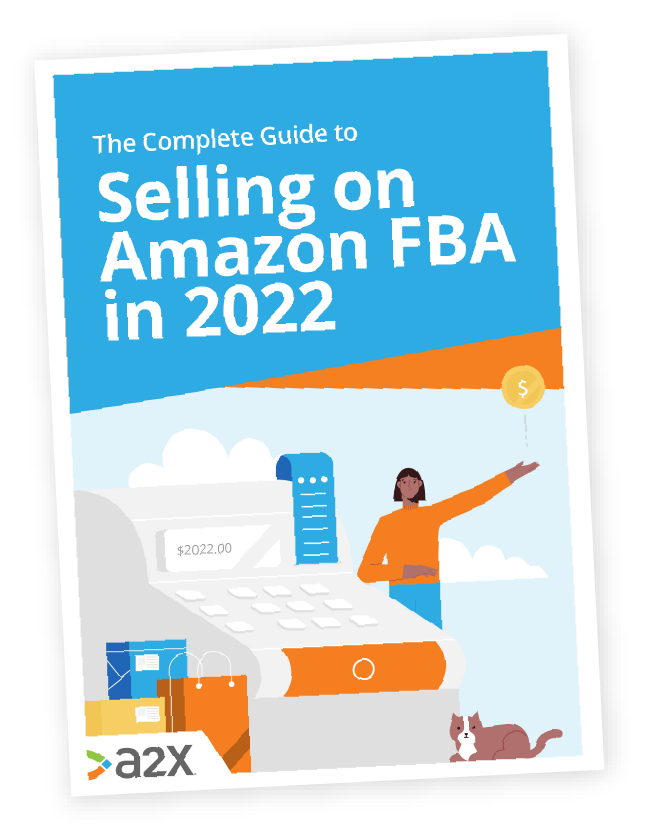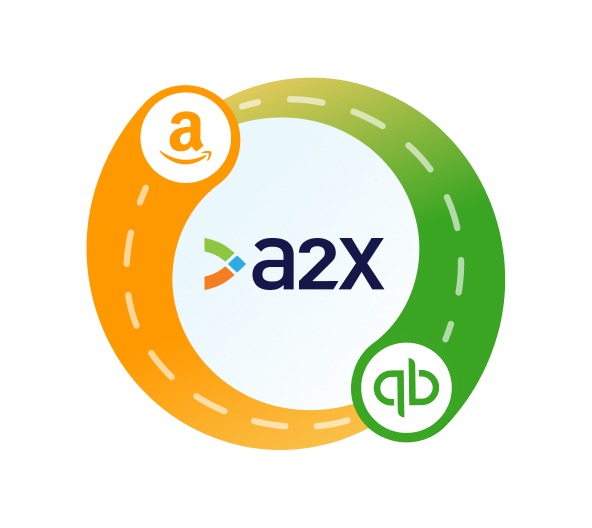![What Are the Best Products to Sell on FBA? [2023 Guide]](/img/content/amazon.jpg)
What Are the Best Products to Sell on FBA? [2023 Guide]
That’s how many visitors Amazon.com recorded in February 2022.
And they’re not just window shopping, either.
According to a Feedvisor survey, 89% of buyers agree that they are more likely to purchase from Amazon than other ecommerce sites.
It’s easy to see why so many sellers set up shop there. But how do they know best products to sell on Amazon FBA?
Find out with this guide.
In this guide to what to sell on Amazon FBA:
Table of Contents
The best advice and insights for selling on Amazon this year
There’s a lot to know when it comes to selling on Amazon. In this guide, you’ll find expert tips and advice to make sure you start strong and stand out from the crowd.
Download our free guide
Ready to open the Pandora’s box that is selling on Amazon FBA?
We are, let’s go.
The Amazon marketplace
Knowing what to sell on Amazon FBA has to start with its customers.
Who are they, and what do they want?
If you don’t consider this before anything else, you’re stabbing in the dark.
**It’s also the only way to deliver the world class customer service that built Amazon, and could be the make or break of your Amazon business too. **
In fact, if you think Jeff Bezos has done well for himself, he says it all comes down to excellent customer service:
“It used to be that if you made a customer happy, they would tell five friends. Now, with the megaphone of the internet, whether online customer reviews or social media, they can tell 5,000 friends… in my view, obsessive customer focus is by far the most protective of Day 1 vitality.”
So with that in mind, let’s get to know the Amazon customer.
Customers come to Amazon for:
Quick, personalized service
Amazon does this by suggesting products they might like based on past behavior, lets them know whether items can be delivered to their location, and enables them to skip checkout processes with automated payment options.
You can offer your customers this experience through Amazon too.
The latest and greatest, for the cheapest
As somewhat of a pioneer in the industry, Amazon anticipates customer needs and fills the gap. For example, Alexa was one of the first voice-controlled devices of its kind to hit the market, and remains the leader amongst its competition.
Amazon also upholds pricing rules so that customers are hard-pushed to find products cheaper elsewhere. Whatever your industry and niche might be, keep informed of its evolution, what’s new, what’s next and what’s cheapest.
Product comparisons, reviews and features
It is estimated that around 23% of online consumers use Amazon for product inspiration. About 82% consider their products based on pricing, and 93% are influenced by reviews.
With visitors coming just to check out your offering, prices and testimonials, no matter what you sell, keep these things top of mind.
Super-fast shipping and seamless fulfilment
Amazon has made itself famous for its unprecedented shipping times. FBA also takes a lot of the customer service away from sellers too, helping make the process smooth, seamless and ultimately left to the experts.
By leveraging FBA, you are opening yourself up to the full potential of selling alongside the world’s biggest ecommerce brand.
**Whatever you sell, it’s important to keep buyer intent and behavior top of mind. **
These things are relevant to all sellers and should dictate how you sell, no matter the product.
But now let’s have a look at what to sell, the reason you’re here.
We’ll explore some of the top products historically for Amazon, whether there are any barred items and how to pick and purchase your inventory.
The best products to sell on Amazon by category
When looking at what to sell on Amazon, it might seem like the logical first place to start is popular product categories.
And there’s nothing wrong with this step, but it shouldn’t be the only one - here’s why.
In 2019, Electronics was the best-selling Amazon category. In 2020/1, it’s Home and Kitchen.
The COVID-19 pandemic has had an enormous impact on ecommerce in general. The average marketplace seller annual revenue rose from $100,000 the year prior, to $160,000.
Source: DigitalCommerce360.
Consumers were stuck indoors, so it makes sense that spending on home products rose.
But what does this tell us? That timing matters, and that popular categories and historic trends are only so helpful. A popular category could be less profitable, over saturated, too competitive and even short-lived.
Most profitable vs. most popular Amazon categories
Here’s a comparison of Amazon’s 10 most popular vs. most profitable categories, based on an updated Jungle Scout report.
We’ve noted margins that have increased/decreased since the 2021 report.
Popular Categories (% sales) | Profitable Categories (% average profit margin) | |
Most | Home & Kitchen (32% - down from 40%) | Handmade (32% - up from 26%) |
Beauty & Personal Care (23% - up from 19%) | CDs & Vinyl (27% - up from 24%) | |
Toys & Games (20% - up from 19%) | Apps & Games (25% - up from 24%) | |
Clothing, Shoes & Jewelry (18%) | Industrial & Scientific (25%) | |
Health, Household & Baby Care (17% - down from 18%) | Luggage & Travel Gear (25%) | |
Sports & Outdoors (16% - down from 21%) | Grocery & Gourmet Food (23%) | |
Arts, Crafts & Sewing (15%) | Video Games (23% - down from 26%) | |
Books (15%) | Arts, Crafts & Sewing (22%) | |
Kitchen & Dining (14% - down from 16%) | Pet Supplies (22% - down from 23%) | |
Least | Baby (14%) | Musical Instruments (21%) |
A notable drop was seen in the average profit margin of Computers which sat at 28% last year, and only 16% today, at the time of writing.
Top Amazon sellers and their products
The list of top 10 Amazon.com sellers at the time of publishing, with their main categories of products, include:
- Pharmapacks - A seller made famous by its seemingly random inventory.
- AnkerDirect - Electronics.
- EPFamily Direct - Home & Kitchen, Automotive and Office Supplies…
- Utopia Deals - Home & Kitchen, Clothing, Shoes, Personal Care…
- VM Express - Patio, Lawn & Garden, Home & Kitchen, Sports & Outdoors…
- Zappos - Shoes.
- MetroDecor - Similar to EPFamily Direct, selling Home & Kitchen, Office, Beauty…
- iServe - Health & Household, Clothing, Shoes, Jewelry, Sports & Outdoors…
- Decluttr Store - Refurbished tech, second-hand media.
- Juvo+ - Similar to EPFamily Direct, selling Home & Kitchen, Office, Arts & Crafts…
What do all these percentages and categories show?
That there is potential across the board.
What you want is high demand and low competition, which is not necessarily dictated by category.
You need to dig deeper, find your niche and dominate it.
Some categories also require a higher level of experience than others. What to sell on Amazon for beginners will look different to seasoned pros (we’ll talk about that below).
The need should come before the product. What need are you trying to supply? What evidence do you have that it exists?
Now we’re getting to the research phase, but before we do that, let’s quickly cover what is not an option to sell on Amazon.
What can’t you sell? The Amazon gated categories list
“The sale of illegal, unsafe, or other restricted products listed on these pages, including products available only by prescription, is strictly prohibited.”
Here are a few restricted categories on Amazon:
- Alcohol
- Animals & Animal-Related Products
- Art
- Automotive and Powersports
- Cosmetics & Skin/Hair Care
- Currency, Coins, Cash Equivalents, and Gift Cards
- Dietary Supplements
- Drugs & drug paraphernalia
- Electronics
- Explosives, Weapons, and Related Items
- Food & Beverage
- Gambling & Lottery
- Hazardous and Dangerous Items
- Jewelry & Precious Gems
- Lighting
- Medical devices and accessories
- Offensive and Controversial Materials
- Plant and Seed Products
- Tobacco & Tobacco-Related Products
- Warranties, Service Plans, Contracts, and Guarantees
- Upholstered Furniture, Bedding, & Other Quilted Products
You can find the full list with all relevant policies here.
If you are a beginner or not an expert on the above product types, it’s probably best to avoid them altogether. If you’re keen to explore them, make sure to do your research.
Amazon can shut you down with little warning, so it’s worth ensuring you’re above board from the start.
How to research and pick products to sell on Amazon
If you’re wondering how to find profitable products to sell on Amazon, it’s all in the research. And that’s not a one-time job, either.
Remember how we said that timing is critical? Your first strategy may not stand the test of time, so keep challenging it and adjusting as you go.
Tips for finding products to sell on Amazon
Picking a popular category means competing with Amazon itself
Amazon will put its own-branded products ahead of yours in search results, whether they rank as highly or not. AmazonBasics products will also likely be cheaper than yours.
Picking a popular category could mean saturation and higher ad costs
Competing in a market that is well-established is a risky strategy, you need to bring something new to the table. Plus, if you are competing with a lot of others, the cost of your advertising will be higher too, which isn’t ideal if you’re just starting out.
Try Google Trends for product ideas in less competitive categories
Get into the habit of looking at Google Trends often. See what the market is looking for, the demographic and what keeps coming up. JungleScout also has a few tools to help you find high-demand, low-competition niches too, once you have some ideas from trend research.
Keep an eye on wider consumer behavior
Consumer behavior is always changing and although unprecedented events like COVID-19 don’t happen every day, demands do change, and savvy sellers need to stay on top to survive.
Find the data and stick to it
Figuring out what to sell on Amazon to make money needs to be data-driven. Don’t pick a product simply because you like it, you need to find evidence that it will perform in the market.
The best products to sell on Amazon FBA change constantly.
They depend not just on what they are and the category they belong to, but how the seller lists them, when, and how they leverage the tools on the platform.
Only by bringing together these multiple factors and staying informed about the industry and market as it evolves, can you dominate the ecommerce beast that is Amazon.com.
How to source products for Amazon
We have a dedicated guide to finding and managing your Amazon suppliers.
In it, you’ll discover where to buy products to sell on Amazon by business model, how to establish great relationships with the best companies, and tips for ongoing management.
Here’s a quick refresh on business model types and basic sourcing information.
Tips for sourcing products by business model
Private labeling
This consists of creating your own product or label, which is particularly popular among Home & Kitchen and Handmade categories. A guide to getting started with private labelling on Amazon.
Retail arbitrage
This consists of finding low-cost items in physical stores that you resell. This is popular among Apps & Games but not in Kitchen & Home or Industrial categories. A guide to retail arbitrage on Amazon.
Online arbitrage
This is like the above but rather than shopping on the street, you find discount items online. Between ecommerce platforms is tricky and frowned upon - so beware. This is popular for Apps & Games and Video Games but not for Home & Kitchen or Sports & Outdoor. Top tips from a successful online arbitrage Amazon seller.
Wholesaling
This consists of buying in bulk and is popular among the Musical Instruments and Food categories, but less in Books, CDs & Vinyl. It’s not hard to find wholesale products to sell on Amazon. Get tips and actionable next steps here.
Dropshipping
The model that consists of having no inventory at all, but rather fulfilling orders via the supplier. This happens a lot in the Computer, Collectibles, Fine Art and Electronics categories, and less among Luggage, Travel and Food. Guide on getting set up with dropshipping for Amazon.
Handmade selling
As the name suggests, these sellers create their own products. Help with starting an Amazon Handmade business.
How to sell items on Amazon (the next steps)
Once you have an idea of what you’d like to sell and your business model, your next focus is on how you’ll sell.
If you don’t have one yet, we highly recommend creating an Amazon FBA Business Plan.
Armed with this, you’ll have a better idea of where you want your business to go, and foundations to make informed decisions with the bigger picture in mind.
Check out some of our other guides below for the next steps in your Amazon FBA journey:
- How to Sell on Amazon FBA in 2023
- Everything You Need To Know About Amazon’s FBA Service
- The Amazon Accounting Hub
- Understanding Amazon FBA Seller Fees
- Amazon Pay Guide: Everything You Need to Know
You can also find a wealth of other resources about selling on Amazon from SEO to sales tax, accounting, automation and growth strategies on our blog.
Prioritize Your Amazon accounting early
One thing any seasoned Amazon seller will tell you is that reconciling their statements is not straightforward.
But succeeding in business depends on accurate accounting, so it’s worth knowing upfront what automation options exist to handle this for you.
Give up your hours of manual reconciliation and let A2X make sense of your Amazon settlements for you. Capturing every income and expense line that make up your bank deposits, A2X calculates your data automatically, sending it to your accounting software in neat journal summaries.
A2X organizes your books via the accrual method so that all your forecasting and planning can be based on accurate, reliable numbers.
Try A2X for Amazon & QuickBooks Online or Xero for free!
Also on the blog
The best advice and insights for selling on Amazon this year
There’s a lot to know when it comes to selling on Amazon. In this guide, you’ll find expert tips and advice to make sure you start strong and stand out from the crowd.
Download our free guide


